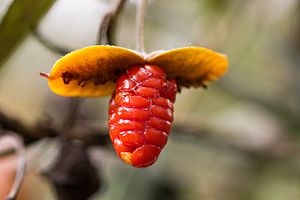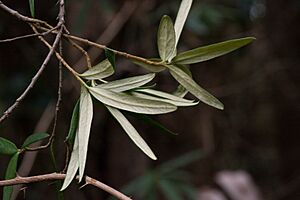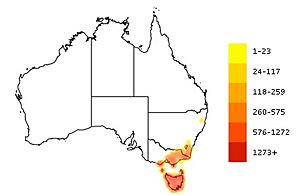Cheesewood
Quick facts for kids Cheesewood |
|
|---|---|
 |
|
| Pittosporum bicolor fruit | |
| Scientific classification | |
| Genus: |
Pittosporum
|
| Species: |
bicolor
|
Pittosporum bicolor, also called cheesewood or banyalla, is a beautiful flowering shrub or small tree. It belongs to the Pittosporaceae plant family. You can find it growing naturally in southeastern Australia. This plant is very common. It often grows under taller trees in wet forests in New South Wales, Victoria, and Tasmania.
Contents
About Its Name
Scientists give every living thing a special name. This helps everyone know exactly which plant or animal they are talking about. The plant Pittosporum bicolor got its name from a scientist named William Jackson Hooker. He first described it in 1834. He wrote about it in a paper called Contributions Towards a Flora of Van Deimen's Land.
The name Pittosporum is for a group of about 200 different plant species. These plants are always green and have flowers. They all belong to the Pittosporaceae family.
What It Looks Like
The leaves of Pittosporum bicolor are long and narrow. They can be 2 to 8 centimeters (about 1 to 3 inches) long. They are usually 5 to 18 millimeters wide. The edges of the leaves can be flat or slightly curled. The tip of the leaf is often rounded.
The leaves grow one after another along the stem. They are special because they have two different colors. The top side of the leaf is a shiny dark green. The bottom side is a lighter green or silver-gray. The bottom side is covered in tiny white hairs. Sometimes, the top side might have a few hairs too.
Flowers
This plant blooms in the spring. Its pretty flowers usually grow where the leaves meet the stem. They can also grow at the very end of a branch. Sometimes, they grow in small groups.
The flowers are shaped like bells. They have 5 sepals, which are small leaf-like parts at the base of the flower. These sepals are about 5 to 6 millimeters long. They curve slightly inwards. The outside of the sepals has fine white hairs.
The flowers also have 5 petals. These petals are 8 to 11 millimeters long and curve backwards. The outside color of the petals can be dark red or yellow. The inside is usually a lighter color. Each flower has 5 stamens (male parts) and one pistil (female part). The pistil's base, called the ovary, is covered in fine hairs. Each flower grows on a long stem called a pedicel, which also has fine hairs.
Fruit
The fruit of Pittosporum bicolor is a round, woody capsule. It is covered in fine white hairs. As it gets older, its color changes from orange to brown. When the capsule is ready, it splits in half. Inside, you can see rows of 8 to 20 sticky seeds. These seeds are red or orange. You can also see dark valves on the inside of the open capsule.
Bark
The bark of the plant is gray to light brown. Near the bottom of the plant, the bark looks smooth and a bit scaly. Higher up, it looks rougher and like paper.
Size and Shape
This plant usually grows in a cone shape. It can reach a height of 2 to 10 meters (about 6 to 33 feet). Sometimes, it can grow even taller.
Where It Lives
You can find Pittosporum bicolor all over Tasmania and the Bass Strait Islands. It also grows in the very southeastern parts of New South Wales and Victoria (see Figure 1).
It grows as a shrub or a small tree in wet forests. It likes to grow in shady spots under bigger trees. It prefers soil that is moist and drains water well. You usually won't find it growing higher than 1,000 meters (about 3,300 feet) above sea level.
Sometimes, Pittosporum bicolor can grow on other plants. It often grows on soft tree ferns like Dicksonia antarctica. This might be a way for its young plants to avoid being eaten by animals.
Similar Plants
There is a hybrid plant called Pittosporum undulatum spp. emmetti. This plant is a mix of P. bicolor and another plant called Pittosporum undulatum. The hybrid plant looks like a combination of its two parent plants.
Growing It in Your Garden
P. bicolor is not a very common plant to grow in gardens. However, its beautiful and sweet-smelling flowers can be very appealing.
If you want to grow it, it likes soil that drains well. It can grow in a sunny spot, but it also does well in a sheltered or shady place. While it can survive in dry soil, it prefers moist soil, similar to where it grows naturally. You can prune it quite a lot if you need to.
How to Grow New Plants
You can grow new P. bicolor plants from seeds or cuttings. You can collect the ripe seeds and plant them directly. They will usually sprout easily. For cuttings, you should take a piece from a semi-hard branch. Make sure the cutting includes a small piece of the older stem at its base.
Growing from seeds is often more successful than growing from cuttings. However, be careful when planting seeds. Different Pittosporum species can easily mix together and create new hybrid plants.
Gallery












